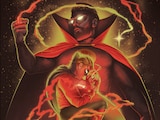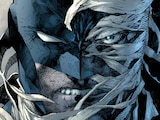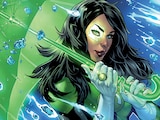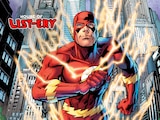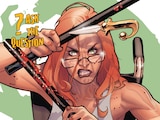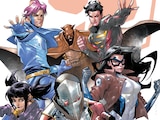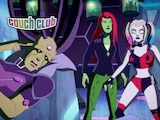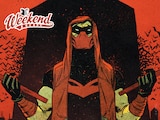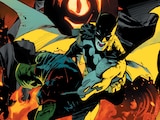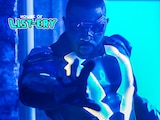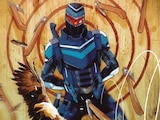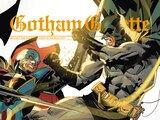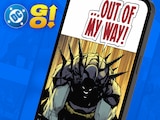There’s a pretty big debate about who the true leader of the Justice League is. It’s often a toss-up between who deserves this weighty position of leadership versus who may be best suited for the part. If we’re being even more honest with ourselves, it’s often an argument that comes down to Batman and Superman (anyone remember when Nightwing led the Justice League? That was pretty awesome!). In spite of that, on the day before the release of the Justice League movie, and with a new episode of Arrow airing tonight on The CW, I want to make the case about why the leader of the greatest superhero team of all time isn’t either of the big two. Nor is it Wonder Woman, even though she arguably takes on that role in the movie.
It’s actually Black Canary.
Dinah Drake was a member of the Justice Society of America until it got shunted off to Earth-2, and when the Justice League got an Earth-1 facelift, Dinah Lance became the tenth member of what would become the most iconic superhero team of all time. She was the member that grew the size of the team into double digits, which is a pretty monumental feat, when you think about it. In the scope of superhero teams, there are very few that have ever reached that impressive a roster.

Now, that at face value is by no means evidence of why someone ought to be in charge of anything, much less the Justice League. It’s at most a fun fact. However, part of the reason I believe Dinah makes a better Justice League leader than either Superman or Batman is because she possesses the best qualities of both of them. With her Canary Cry, Dinah has an impressive and unique metahuman ability. This gives her the ability to think critically about how other metahumans can be deployed both offensively and defensively as might be needed depending on the extremity of the situation. This makes her like Superman.
Not only that, but Dinah Lance is a phenomenally well-trained fighter. Her hand-to-hand combat skills are next level good. This is something that the #DCTV world really embraced with the creation of Sara Lance, who currently enjoys the title of White Canary. Similarly, in the Young Justice animated series, Black Canary trains the legacy characters to ensure that they are not only able to handle their own, but live up to the work of their mentors. Much like Batman, she has operated for a long time as a vigilante (often alongside Green Arrow), working in the shadows and bucking the status quo in order to protect those who might come against her.
So, she has these two tremendous qualities and she’s in with the superkids. Where does this give her the authority to lead their mentors? Much of it comes by way of Mark Waid and Brian Augustyn in their JLA: YEAR ONE story. The Black Canary that they present in this reimagining of the Justice League origin is nothing short of impressive. She immediately rises above the rest (Aquaman, Green Lantern, Flash and Martian Manhunter) as both the most empathetic member of the team, but also one who will not stand for any nonsense. Over the course of the story, she gains the respect of her four team members through her actions and deeds even more than her words. Over the course of twelve issues, she plays an integral part in carving from stone a contemporary look at this iconic organization.
If you are looking for some pre-movie reading you might want to pick up JLA: Year One, come to think of it. It’s all available digitally.

This Black Canary remained an active member of the Justice League when Grant Morrison and Howard Porter took over the team in their acclaimed run. They continued the tradition that JLA: Year One began of Dinah aggressively expanding the roster of heroes that can call themselves “Leaguers.” What was more important, though, is that when Brad Meltzer got a crack at writing the team, he put Black Canary back in charge of things. There are some pretty big changes to the history and established timeline of the League around this time, and I, for one, find it very fitting that Dinah was the herald of this shifting status quo.
Not only is she able to bridge two of most defining aspects of superheroes within the DC Universe, but twice she has been on the forefront of redefining not only what it means to be a member of the Justice League (in whatever the current, most in-vogue incarnation is), but what it means to be the Justice League.
I want to circle back around to her work as a mentor in Young Justice. If we accept that Dinah helped train young heroes relatively early in her life as Black Canary, then later on when she comes to lead the Justice League, she is singularly positioned to know which of the up-and-coming crop of heroes to keep an eye on when the Justice League needs new members.

We should also look at it from the outside, as comic book readers. Black Canary is an intriguing proposition to head up the biggest team book on the shelf. Other characters like Wonder Woman, Superman or Batman have to serve multiple narratives in a number of titles, whereas Black Canary can solely serve the story being told in the team book. (Granted, that’s NOT being done right now at DC. Dinah’s stretched pretty thin between her roles in GREEN ARROW, BATGIRL AND THE BIRDS OF PREY and JUSTICE LEAGUE OF AMERICA.) Theoretically, that would serve the book better and allow the narrative to be more focused. I’m not contending that there aren’t wonderful stories that are being and have been told with big characters like Superman or Batman in charge. I just think Black Canary is in a heightened position to serve the Justice League title.
Dinah (Drake or Lance, however you prefer, but I lean towards Lance, personally) bridges a number of worlds. She brings metahuman and vigilante, original and legacy together and has earned the respect of some of the most badass characters to ever come out of DC. Those are some pretty impressive credentials.
Ashley V. Robinson writes about Rebirth for DCComics.com and covers The Flash for the #DCTV Couch Club. Look for her on Twitter at @AshleyVRobinson.

